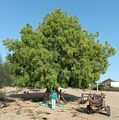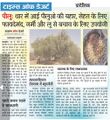Pilu
Pilu (पीलु: pīlu) or Salvadora oleoides or Salvadora persica is a species of Salvadora. Salvadora persica has antiurolithiatic properties. It has been mentioned in Mahabharata at several places.
Variant names
- Arak,
- Galenia asiatica,
- Meswak,
- Peelu,
- Pīlu,
- Salvadora indica,
- Toothbrush tree,
- Mustard tree,
Uses
Used for centuries as a natural toothbrush, its fibrous branches have been promoted by the World Health Organization for oral hygiene use. Research suggests that it contains a number of medically beneficial properties including abrasives, antiseptics, astringent, detergents, enzyme inhibitors, and fluoride.
Character
Salvadora persica is a small tree or shrub with a crooked trunk, seldom more than one foot in diameter. Its bark is scabrous and cracked, whitish with pendulous extremities. The root bark of the tree is similar to sand, and the inner surfaces are an even lighter shade of brown. It has a pleasant fragrance, as well as a warm and pungent taste. It sheds its leaves from late December to January. The leaves break with a fine crisp crackle when the foot falls over them. In Pakistan these ancient, majestic and sturdy trees are more closely associated with graveyards like the cypress tree in English culture.
Salvadora persica is a popular chewing stick throughout the Arabian Peninsula, as well as the wider Muslim world.[11] Also commonly referred to as miswak, it is often mentioned that the Islamic Prophet Muhammad recommended its use. He is quoted in various Hadith extolling the twig's virtues.
Scientific analysis
According to chemical and phytochemical analysis of Salvadora persica, there was an occurrence of carbohydrates and/or trimethylamine; an alkaloid which may effectively be salvadorine; chlorides; sulfur; terpenes; vitamin C; glycosides; large amounts of fluoride and silica; small amounts of tannins, saponins, flavonoids and sterols.
Mention by Panini
Pilu (पीलु) is mentioned by Panini in Ashtadhyayi. [1]
Pilu-kuna (पीलु-कूण) is mentioned by Panini in Ashtadhyayi. [2]
In history
Lepel H. Griffin[3] describes Sirdar Pahar Singh, his character and administration : The new Chief was a liberal-minded and able man, and immensely improved his territory, more than doubling the revenue in twenty years. He founded many new villages, and the lightness of the assessment and his reputation for justice and liberality induced large numbers of cultivators to emigrate from Lahore and Pattiala to his territory.
The larger portion of the State was desert when he acquired it, and the journal of Captain Murray written in 1823, describes the country at sun-rise, as presenting the appearance of a vast sea of sandy with no vegetation except Pilu or other desert shrubs which added little to the life of the landscape. But the soil, although sandy, only required water to produce magnificent crops of wheat.
In Mahabharata
Mahabharata Book II: Sabha Parva
The Mahabharata in Sanskrit Book 2 Sabha Parva Chapter 47 (SECTION L) mentions that The king of Kamboja gave innumerable skins of the best king, and blankets made of wool, of the soft fur of rodents and other burroughers, and of the hair of cats,--all inlaid with threads of gold. And he also gave three hundred horses of the Titteti and the Kalmasha species possessing noses like parrots. And he also gave three hundred camels and an equal number of she-asses, all fattened with the Pilu, Shami and the Anguda. [4]
- अश्वांस तित्तिरि कल्माषांस तरिशतं शुकनासिकान
- उष्ट्रवामीस तरिशतं च पुष्टाः पीलु शमीङ्गुथैः (Mahabharata:II.47.4)
Mahabharata Book II Sabha Parva :Chapter 48 (SECTION LI) mentions about Kichaka Venu (काँटा बांस) : When tribute presented unto Yudhishthira by the kings of the earth, who dwell by the side of the river Sailoda flowing between the mountains of Meru and Mandara and enjoy the delicious shade of topes of the Kichaka Venu (bamboo) viz., the Khashas, Ekasanas, the Arhas, the Pradaras, the Dirghavenus, the Paradas, the Kulindas, the Tanganas, and the other Tanganas, brought as tribute heaps of gold.
- मेरुमन्दरयॊर मध्ये शैलॊदाम अभितॊ नदीम
- ये ते कीचक वेणूनां छायां रम्याम उपासते (Mahabharata: II .48.2)
- खशा एकाशनाज्यॊहाः परदरा दीर्घवेनवः
- पशुपाश च कुणिन्दाश च तङ्गणाः परतङ्ग (Mahabharata: II .48.3)
Mahabharata Book III: Vana Parva
Vana Parva, Mahabharata/Book III Chapter 174 (III.174.23) mentions [5]
....The Holy-fig , the Rudaraksha, the Rohitaka, the Cane and the Jujube, the Catechu, the Sirisha, the Bel and the Inguda and the Karira and Pilu and Sami trees grew on the banks of the Saraswati. Wandering about with contentment in (the vicinity of) the Saraswati which was, as it were, the home of the celestials, and the favourite (resort) of Yakshas and Gandharvas and Maharshis, those sons of kings lived there in happiness.
- पलक्षाक्ष रौहीतक वेतसाश च; सनुहा बथर्यः खथिराः शिरीषाः
- बिल्वेङ्गुथाः पीलु शमी करीराः; सरस्वती तीररुहा बभूवुः (Mahabharata:III.174.23)
- तां यक्षगन्धर्वमहर्षिकान्ताम; आयाग भूताम इव थेवतानाम
- सरस्वतीं परीतियुताश चरन्तः; सुखं विजह्रुर नरथेव पुत्राः (Mahabharata:III.174.24)
Mahabharata Book VII: Drona Parva
Drona Parva Chapter 175 (SECTION CLXXVIII) mentions the battle that took place between Bhima's son Ghatotkacha and Alayudha at Kurukshetra: [6]
...And they struck each other, tearing up many kinds of large-branched trees such as Sami and Pilu and Karira and Champaka, O Bharata, and Inguidi and Vadari and flowering Kovidara and Arimeda and Plaksha and banian and peepul, and also with diverse mountain-summits and diverse kinds of metals. The clash of those trees and mountain-summits became very loud like the roar of driving thunder.
- शमी पीलु करीरैश च शम्याकैश चैव भारत
- इङ्गुथैर बथरीभिश च कॊविथारैश च पुष्पितैः (VII.153.24)
- पलाशैर अरिमेथैश च पलक्षन्यग्रॊधपिप्पलैः
- मयथ्भिः समरे तस्मिन्न अन्यॊन्यम अभिजघ्नतुः (VII.153.25)
- विविधैः पर्वताग्रैश च नानाधातुभिर आचितैः
- तेषां शब्धॊ महान आसीथ वज्राणां भिथ्यताम इव (VII.153.26)
Mahabharata Drona Parva Book VII Chapter 34 describes Abhimanyu's encounter with Drona in battle of Mahabharata.We find mention of Bamboo:
Fragrant with many perfumes, while life was in them, they could speak words both agreeable and beneficial. Diverse cars, well-equipped, and looking like the vapoury edifices in the welkin, with shafts in front and excellent bamboo poles and looking beautiful with the standards set up on them, were deprived of their Janghas, and Kuvaras, and Nemis, and Dasanas, and wheels, and standards and terraces. And the utensils of war in them were all broken.
Mahabharata Book VIII: Karna Parva
Karna Parva/Mahabharata Book VIII Chapter 30 verse 24 mentions tree species as Sami, Pilu and Karir tree species as under in Sanskrit and IAST:
- शमी पीलु करीराणां वनेषु सुखवर्त्मसु (śamī pīlu karīrāṇāṃ vaneṣu sukhavartmasu)
- अपूपान सक्तु पिण्डीश च खाथन्तॊ मदितान्विताः (apūpān saktu piṇḍīś ca khādanto mathitānvitāḥ) (VIII.30.24)
- Meaning - "When shall I be amongst those ladies eating cakes of flour and meat and balls of pounded barley mixed with skimmed milk, in the forests, having many pleasant paths of Sami and Pilu and Karira!" (VIII.30.24)
Mahabharata Book IX: Shalya Parva
Shalya Parva, Mahabharata/Book IX Chapter 36 mentions the biodiversity of River Sarasvati (Sapta-Saraswat). Numerous feathery creatures have their home there. And it abounded with Vadari (Ipomea digitata - Giant potato), Inguda (Balanites roxburghii), Kashmarya (Barberis vulgaris), Plaksha (Balsamodendron mukul -Guggul), Aswattha (Ficus religiosa - Pippal), Vibhitaka (Terminalia bellirica - बहेड़ा ), Panasa (Artocarpus heterophyllus - Jack fruit or Kat-hal), Palasa (Butea monosperma), Karira (Caparis decidua), Pilu (Salvadora oleoides), and diverse other kinds of trees that grow on the banks of the Sarasvati. And it was adorned with forest of Parushaka (?), Bilwa (Aegle marmelos - Bel), and Amrataka, and Atimukta (Hiptage benghalensis - Madhumalati) and Kashanda (?) and Parijata (nyctanthes arbortristis). This is mentioned in shlokas 58-60
- बदरेङ्गुद काश्मर्य पलक्षाश्वत्द विभीतकैः
- पनसैश च पलाशैश च करीरैः पीलुभिस तदा (IX.36.58)
- सरस्वती तीररुहैर बन्धनैः सयन्थनैस तदा
- परूषक वनैश चैव बिल्वैर आम्रातकैस तदा (IX.36.59)
- अतिमुक्त कषण्डैश च पारिजातैश च शॊभितम
- कथली वनभूयिष्ठम इष्टं कान्तं मनॊरमम (IX.36.60)
The Mahabharata in Sanskrit Book IX: Chapter 46
In English translation of this in Chapter 47, Janamejaya said, "For what reason did Agni, the Creator of all the worlds, disappear? How also was he discovered by the gods? Tell me all this in detail."
Vaishampayana said, "Agni of great energy became very much frightened at the curse of Bhrigu. Concealing himself within the entrails of the Sami wood, that adorable god disappeared from the view. Upon the disappearance of Agni, all the gods, with Vasava at their head, in great affliction, searched for the missing god. Finding Agni then, they saw that god lying within the entrails of the Sami wood. (Mahabharata:IX.46.16-18)
- ततस तत्राप्य उपस्पृश्य थत्त्वा च विविधं वसु
- अग्नितीर्दं महाप्राज्ञः स जगाम परलम्बहा
- नष्टॊ न थृश्यते यत्र शमी गर्भे हुताशनः (IX:46.12)
- भृगॊः शापाथ भृशं भीतॊ जातवेथाः परतापवान
- शमी गर्भम अदासाथ्य ननाश भगवांस ततः (IX:46.16)
- परनष्टे तु तथा वह्नौ थेवाः सर्वे सवासवाः
- अन्वेषन्त तथा नष्टं जवलनं भृशथुःखिताः (IX:46.17)
- ततॊ ऽगनितीर्दम आसाथ्य शमी गर्भस्दम एव हि
- थथृशुर जवलनं तत्र वसमानं यदाविधि (IX:46.18)
जाल का वृक्ष
देशज़ वृक्षों में जाल (Salvadora oleoides) का वृक्ष दीर्घजीवी होता है। यह पेङ पश्चिमी राजस्थान में रेगिस्तानी क्षेत्र में बहुतायत पाया जाता है। यह तेज गर्मी, हीटवैब और शीतलहर, जाङा में सदैव हरा-भरा रहता है। जैव विविधता, पारिस्थितिकी तंत्र और मरुस्थलीकरण रोकथाम के लिए बहुपयोगी है। इसके लगने वाले #फल पीलु थार के मेवा के नाम से प्रसिद्ध है। इनमें आयुर्वेदिक गुण भरपूर होते है।
भेराराम भाखर इन्द्रोई, बाङमेर
पौधों वाले माङस्साब (ट्री टीचर ऑफ राजस्थान)
Gallery
References
- ↑ V. S. Agrawala: India as Known to Panini, 1953, p.212
- ↑ V. S. Agrawala: India as Known to Panini, 1953, p.17, 212, 216, 217
- ↑ The Rajas of the Punjab by Lepel H. Griffin/The History of the Fridkot State, p.617
- ↑ http://www.sacred-texts.com/hin/m02/m02050.htm
- ↑ http://www.sacred-texts.com/hin/m03/m03176.htm
- ↑ http://www.bibliotecapleyades.net/vimanas/drona_parva/m07175.htm
Back to Flora










